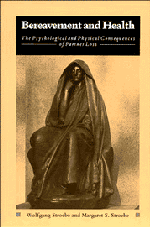Book contents
- Frontmatter
- Contents
- Preface
- 1 Introduction
- 2 The symptomatology of grief
- 3 Is grief universal? Cultural variations in the emotional reactions to loss
- 4 Depression models of grief
- 5 Stress models of grief
- 6 Mediators between stress and illness
- 7 The loss effect: health consequences of marital bereavement
- 8 Risk factors in bereavement outcome
- 9 Reducing the risk of poor bereavement outcome
- References
- Author index
- Subject index
5 - Stress models of grief
Published online by Cambridge University Press: 03 May 2010
- Frontmatter
- Contents
- Preface
- 1 Introduction
- 2 The symptomatology of grief
- 3 Is grief universal? Cultural variations in the emotional reactions to loss
- 4 Depression models of grief
- 5 Stress models of grief
- 6 Mediators between stress and illness
- 7 The loss effect: health consequences of marital bereavement
- 8 Risk factors in bereavement outcome
- 9 Reducing the risk of poor bereavement outcome
- References
- Author index
- Subject index
Summary
Introduction
The death of a spouse is a stressful as well as an emotionally harrowing experience. Thus, by applying depression or stress models to the analysis of partner loss, we are looking at different aspects of the same phenomenon. While depression models construe bereavement in terms of loss and focus on the emotional reaction, stress models view bereavement as a stressful life event, that is, as an experience that overtaxes the coping resources of the individual. The conception of partner loss as a stressful life event integrates the study of bereavement into a body of research which has linked psychosocial stress to a number of health consequences and has isolated various physiological processes assumed to mediate these relationships.
The stress concept has been made popular by Selye's (1936, 1976) seminal work on the General Adaptation Syndrome, a pattern of bodily responses shown to occur whenever the organism is exposed to a stressor (e.g., intensive heat, extreme cold, infection). Although much of the theoretical foundation for this work had been prepared by Cannon (1929), Selye's research, which will be discussed in Section 5.2, has significantly advanced our understanding of physiological reactions to noxious environments.
The second major impetus in the advancement of stress theory came from psychiatrists, who, guided by the teachings of Adolf Meyer, began to study stressful life events as factors contributing to the development of a variety of psychosomatic and psychiatric illnesses.
- Type
- Chapter
- Information
- Bereavement and HealthThe Psychological and Physical Consequences of Partner Loss, pp. 77 - 100Publisher: Cambridge University PressPrint publication year: 1987



